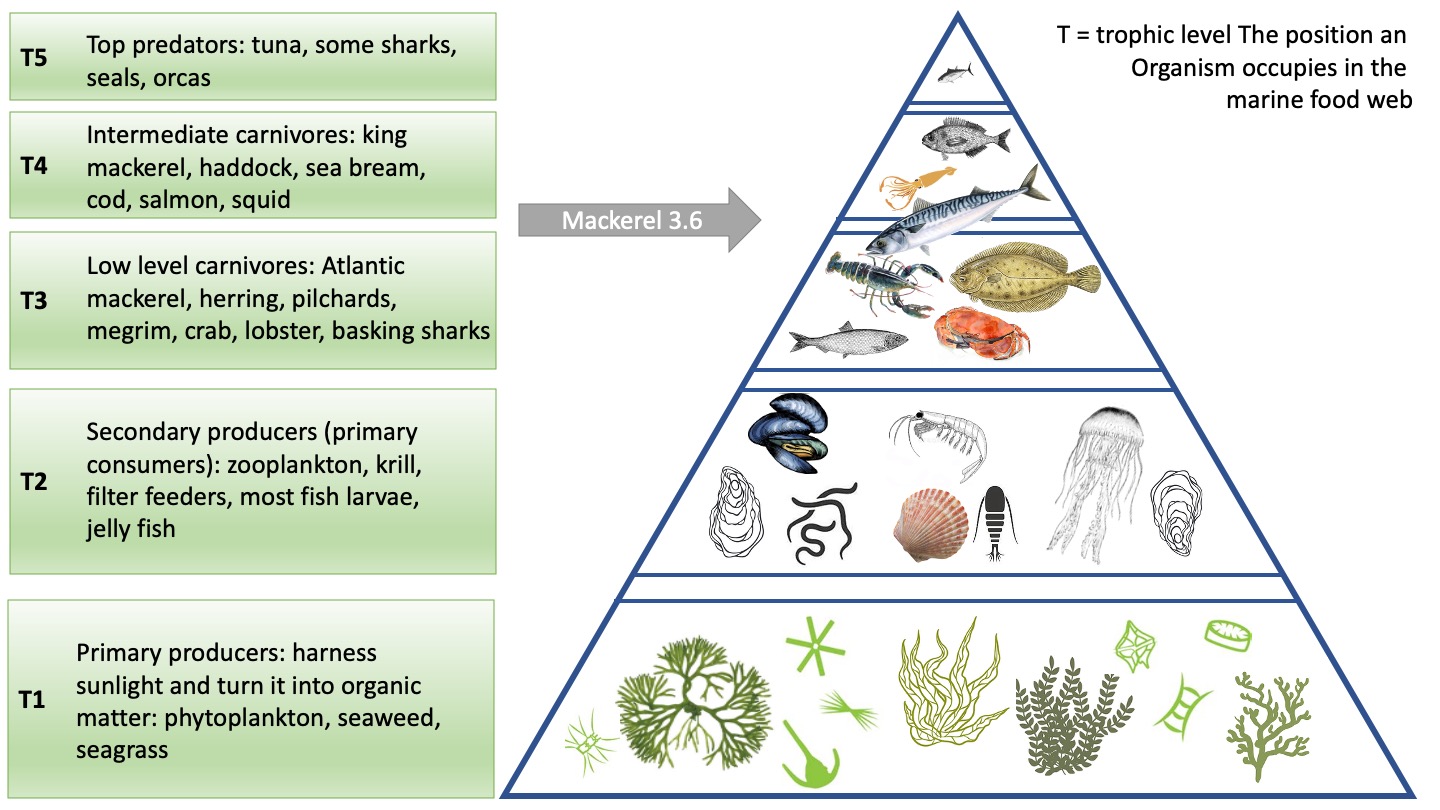Sustainability of Mackerel fishery in Ireland
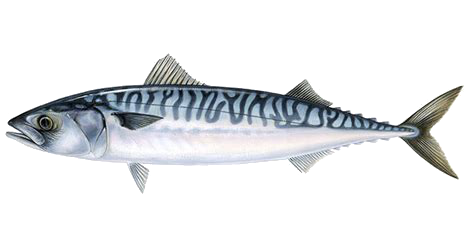
- Sustainability rating: 2
- MSC rating: 3
- IUCN: least concerned
- Avoid spawning season: February - early July
- Main Irish fishing method: Midwater otter trawl
- Recommended minimum size: 18cm
The northeast Atlantic mackerel stock that spawns along the southwest coasts of Ireland is currently sustainably harvested. But the situation is a bit more complex and the industry has not retained its Marine Stewardship Council (MSC) certificate. Here, we try to give you an overview of the complexity of the mackerel fishing industry and start with a summary of the most recent history.
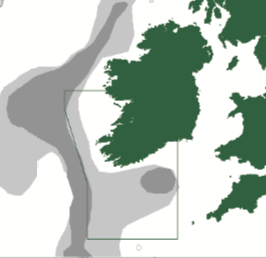
Mackerel has bounced in and out of the MSC certification scheme since the first certificate in 2007. It was celebrated as an international success story in sustainable fisheries management when the first fishery received its MSC certificate.

However, a crisis erupted in 2010 regarding the fishing of mackerel in the northeast Atlantic after the Faroes and Iceland both independently increased their mackerel catches against the European catch agreement and against the advice on quota of the scientific assessment body the International Council for the Exploration of the Sea (ICES). The two countries asserted that mackerel were feeding in greater numbers in their own waters during the summer months and that they should therefore have the rights to larger catches.

It is true that climate and other related environmental fluctuations constantly bring about big changes in the geographic distribution of the mackerel fishery – considered one of the eight ‘big movers’ in ICES’ 2019 stock distribution report (see here for the ICES explanation to the report). However, the Faroese and Icelandic decision pushed the quantity of mackerel being fished across the Northeast Atlantic to a total catch in 2011 that was 38% greater than the upper limit recommended by ICES. As a result, in April 2012 the Marine Stewardship Council suspended sustainability certification (MSC) status for seven individual mackerel fisheries in Europe, the UK and Scandinavia.
Earlier this year in 2020, the relevant conformity assessment bodies (CABs) said that despite the May 2019 catch advice revision upwards, the crucial "harvest control rules" in these fisheries still no longer meet the MSC standard. According to CABs, the biggest problem is the absence of a long-term management strategy for the northeast Atlantic mackerel agreed by all parties involved in mackerel fisheries. There is still a continuing dispute over mackerel quota allocation resulting in annual catches well in excess of the advised catches. It is therefore more vital than ever that the mackerel-fishing Coastal States set mackerel quota for the region according to scientific advice, agreeing and allocating shares to ensure the long-term sustainability of the stock.
The challenge is setting quotas in line with this scientific advice and adopting management rules such as Harvest Control Rules (HCRs) that are key components of achieving the MSC standard, because they are notoriously difficult to attain in international fisheries due to the complexity of multi-national agreements.
But without a robust plan and a commitment to stick to it, fish stocks are subject to increased fishing pressure, particularly stocks like the Atlantic mackerel that migrate over large distances, moving in and out of management zones under relatively rigid quota allocations.
Unfortunately, the pressure of maintaining or retaining the very strict MSC certification is mostly felt by the industry and not – as it should be at least partly - by the Coastal States responsible for setting and allocating quota shares. - MSC blog by Erin Priddle
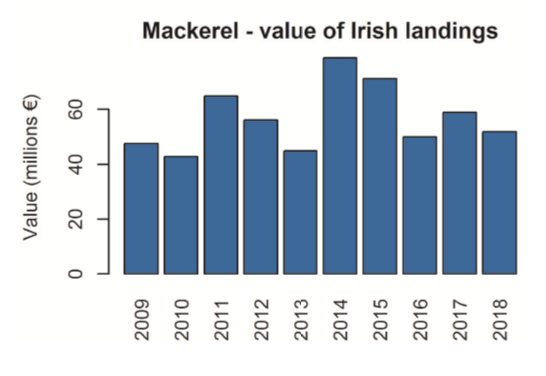
According to the (Marine Institute fish stock book (2019), on average approx. 75,300 tonnes of mackerel were caught and landed by Irish vessels between 2016 and 2018. It is the most valuable pelagic stock to Ireland worth around €51.8m in 2018. Currently, Ireland has 17% of the overall EU total allowable catch (TAC). Advice from ICES for Atlantic mackerel catches in 2020 should not exceed 922,064 tonnes in total.
Historically, the TAC has been divided into a North Sea TAC (EU and Norway), a Western TAC (EU, Norway and Faroes), a Southern TAC (EU) and a NEAFC TAC (Coastal States and Russia). However, there has been no TAC agreement involving all fishing parties since 2008. This highlights the issues of migrating species and the challenge to put in place long-term management plans on an international level as briefly discussed above.

The Irish quota of 55,313 t for 2019 was derived from the Western TAC. Some thousand tonnes of this may be fished in EU waters and Norwegian waters during very specific periods only (1 Jan – 15 Feb and 1 Oct - 31 Dec 2019), a small percentage can be fished in Faroese waters. Irish pelagic fishermen have received a timely and welcome boost following negotiations on the 2020 mackerel total allowable catch (TAC), resulting in a 41% quota increase for Ireland’s fleet. Small scale boats operating close to the shore have another set of rules and no allocated quota or periods to fish for mackerel altogether.
Even though annual catches of the northeast Atlantic mackerel over the past decade have substantially exceeded the advised catch, stocks that were recruited in 2016 and 2017 are estimated to be particularly strong and believed to be able to sustain the current fishing pressure. However, the lack of a long‐term management strategy for northeast Atlantic mackerel across all parties involved in the mackerel fishery is worrying. Fish do not respect geographical boundaries so it is imperative that fishing nations co-operate to jointly implement effective management regimes. This is the only way, both fisheries and the marine environment can be preserved on a the long-term basis.
In regards to the North Sea stock, ICES recommends that the existing measures to protect this spawning component should remain in place. Prior to the late 1960s, spawning biomass of the North Sea component (i.e. mackerel with an affinity for spawning in the North Sea) was estimated at above 2.5 million tonnes. Overexploitation reduced the size of the North Sea population and it has not recovered despite decades of protection. Studies indicate that the lack of recovery is related to unfavourable environmental conditions (Jansen, 2014). Consequently, ICES considers that the North Sea spawning mackerel should be protected to conserve stock structure and dynamics in the northeast Atlantic mackerel stock (ICES, 2017).
The existing management measures to ensure the protection on the North Sea component should therefore remain in place for precautionary reasons. However, an evaluation of the relevance of the minimum conservation reference size in relation to stock production and conservation is needed.
In conclusion: Northeast Atlantic mackerel is currently harvested sustainably and mackerel stocks are doing very well in most European fishing grounds with the exception of the North Sea stock. However, a long-term management plan that involves all parties in the mackerel fishing industry is desperately needed to retain MSC certificate status and to ensure sustainability in the long term.
If you are interested in reading more about this complex issue and you don’t shy away from big, complex topics you may want to read the Fishery Standard Review (FSR), published by the MSC in early 2019. It outlines the future for the northeast Atlantic mackerel and includes fisheries governance and “yo yo fisheries” (fluctuating fisheries). It considers issues raised by stakeholders and data from the MSC’s own monitoring and evaluation team. The aim of this review is to make sure scientific developments and fisheries management best practice are reflected in MSC certified fisheries.
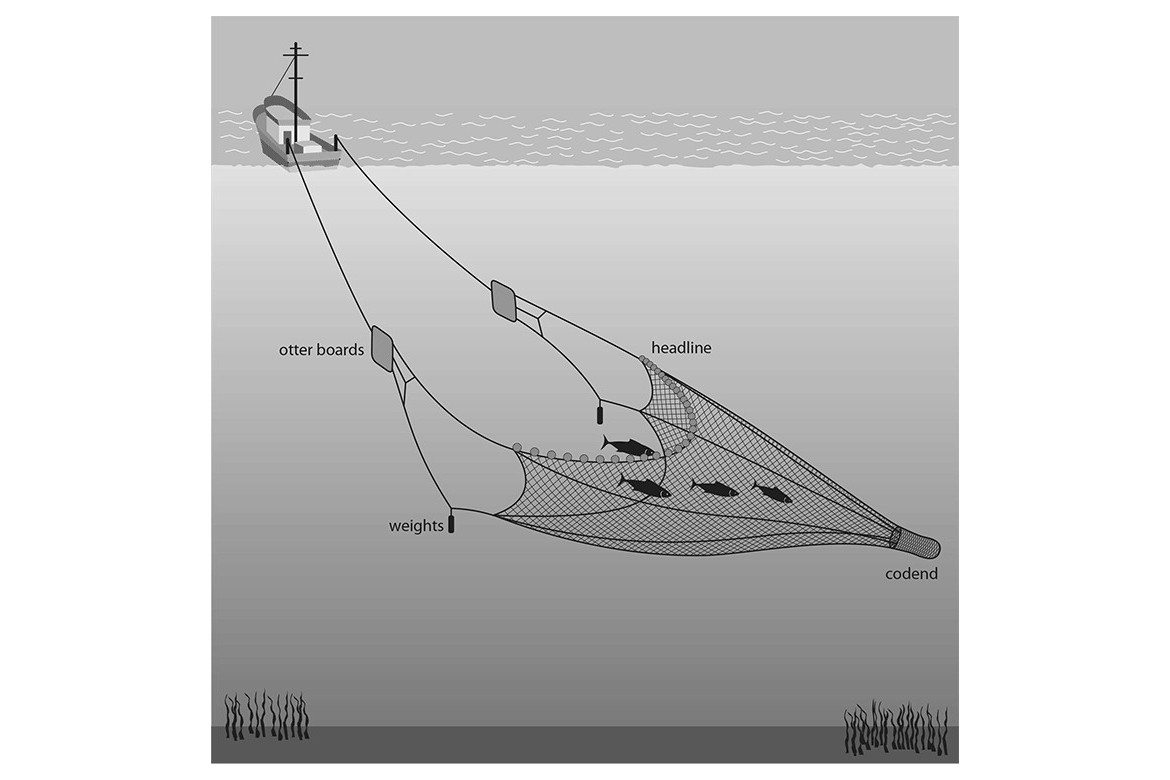 The image on the left shows a midwater trawl which is the most commonly used method to catch mackerel. However, some small scale fishers also deliver gillnet and line caught mackerel to your local fishmongers depending on the season. This is a slightly more sustainable choice due to less by-catch.
The image on the left shows a midwater trawl which is the most commonly used method to catch mackerel. However, some small scale fishers also deliver gillnet and line caught mackerel to your local fishmongers depending on the season. This is a slightly more sustainable choice due to less by-catch.
Mackerel in the Marine Food Pyramid
